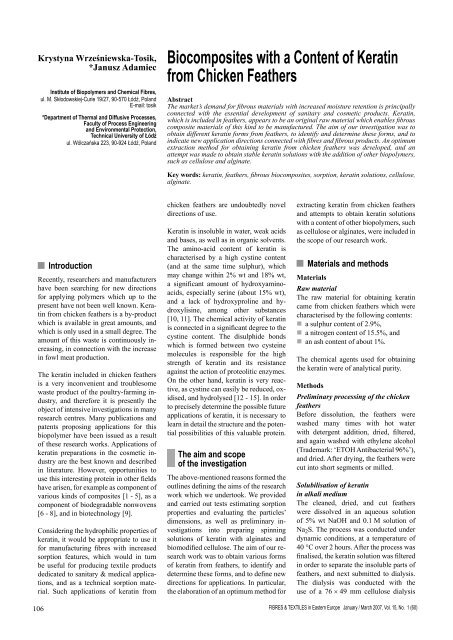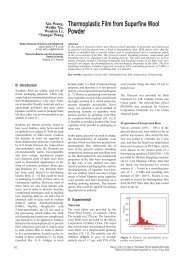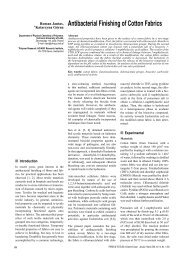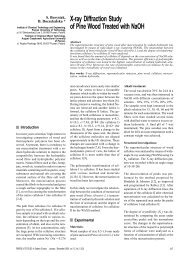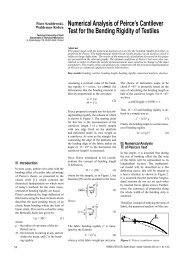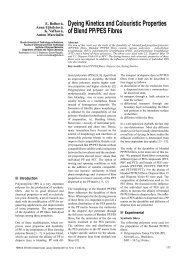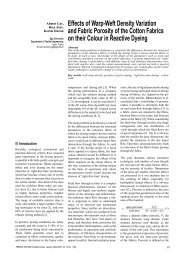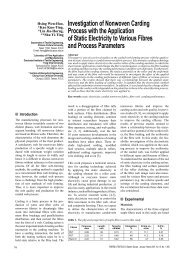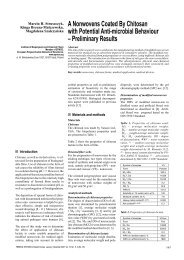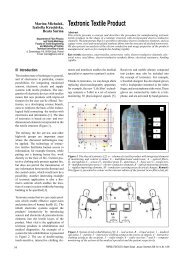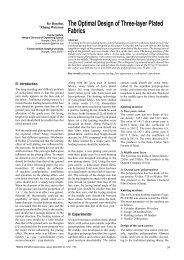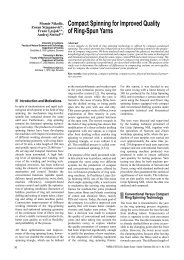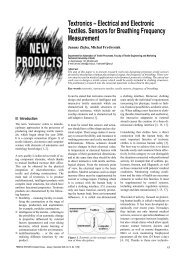Biocomposites with a Content of Keratin from Chicken - Fibres ...
Biocomposites with a Content of Keratin from Chicken - Fibres ...
Biocomposites with a Content of Keratin from Chicken - Fibres ...
You also want an ePaper? Increase the reach of your titles
YUMPU automatically turns print PDFs into web optimized ePapers that Google loves.
Krystyna Wrześniewska-Tosik,<br />
*Janusz Adamiec<br />
n Introduction<br />
Recently, researchers and manufacturers<br />
have been searching for new directions<br />
for applying polymers which up to the<br />
present have not been well known. <strong>Keratin</strong><br />
<strong>from</strong> chicken feathers is a by-product<br />
which is available in great amounts, and<br />
which is only used in a small degree. The<br />
amount <strong>of</strong> this waste is continuously increasing,<br />
in connection <strong>with</strong> the increase<br />
in fowl meat production.<br />
The keratin included in chicken feathers<br />
is a very inconvenient and troublesome<br />
waste product <strong>of</strong> the poultry-farming industry,<br />
and therefore it is presently the<br />
object <strong>of</strong> intensive investigations in many<br />
research centres. Many publications and<br />
patents proposing applications for this<br />
biopolymer have been issued as a result<br />
<strong>of</strong> these research works. Applications <strong>of</strong><br />
keratin preparations in the cosmetic industry<br />
are the best known and described<br />
in literature. However, opportunities to<br />
use this interesting protein in other fields<br />
have arisen, for example as component <strong>of</strong><br />
various kinds <strong>of</strong> composites [1 - 5], as a<br />
component <strong>of</strong> biodegradable nonwovens<br />
[6 - 8], and in biotechnology [9].<br />
Considering the hydrophilic properties <strong>of</strong><br />
keratin, it would be appropriate to use it<br />
for manufacturing fibres <strong>with</strong> increased<br />
sorption features, which would in turn<br />
be useful for producing textile products<br />
dedicated to sanitary & medical applications,<br />
and as a technical sorption material.<br />
Such applications <strong>of</strong> keratin <strong>from</strong><br />
106<br />
Institute <strong>of</strong> Biopolymers and Chemical <strong>Fibres</strong>,<br />
ul. M. Skłodowskiej-Curie 19/27, 90-570 Łódź, Poland<br />
E-mail: tosik<br />
*Department <strong>of</strong> Thermal and Diffusive Processes,<br />
Faculty <strong>of</strong> Process Engineering<br />
and Environmental Protection,<br />
Technical University <strong>of</strong> Łódź<br />
ul. Wólczańska 223, 90-924 Łódź, Poland<br />
<strong>Biocomposites</strong> <strong>with</strong> a <strong>Content</strong> <strong>of</strong> <strong>Keratin</strong><br />
<strong>from</strong> <strong>Chicken</strong> Feathers<br />
Abstract<br />
The market’s demand for fibrous materials <strong>with</strong> increased moisture retention is principally<br />
connected <strong>with</strong> the essential development <strong>of</strong> sanitary and cosmetic products. <strong>Keratin</strong>,<br />
which is included in feathers, appears to be an original raw material which enables fibrous<br />
composite materials <strong>of</strong> this kind to be manufactured. The aim <strong>of</strong> our investigation was to<br />
obtain different keratin forms <strong>from</strong> feathers, to identify and determine these forms, and to<br />
indicate new application directions connected <strong>with</strong> fibres and fibrous products. An optimum<br />
extraction method for obtaining keratin <strong>from</strong> chicken feathers was developed, and an<br />
attempt was made to obtain stable keratin solutions <strong>with</strong> the addition <strong>of</strong> other biopolymers,<br />
such as cellulose and alginate.<br />
Key words: keratin, feathers, fibrous biocomposites, sorption, keratin solutions, cellulose,<br />
alginate.<br />
chicken feathers are undoubtedly novel<br />
directions <strong>of</strong> use.<br />
<strong>Keratin</strong> is insoluble in water, weak acids<br />
and bases, as well as in organic solvents.<br />
The amino-acid content <strong>of</strong> keratin is<br />
characterised by a high cystine content<br />
(and at the same time sulphur), which<br />
may change <strong>with</strong>in 2% wt and 18% wt,<br />
a significant amount <strong>of</strong> hydroxyaminoacids,<br />
especially serine (about 15% wt),<br />
and a lack <strong>of</strong> hydroxyproline and hydroxylisine,<br />
among other substances<br />
[10, 11]. The chemical activity <strong>of</strong> keratin<br />
is connected in a significant degree to the<br />
cystine content. The disulphide bonds<br />
which is formed between two cysteine<br />
molecules is responsible for the high<br />
strength <strong>of</strong> keratin and its resistance<br />
against the action <strong>of</strong> proteolitic enzymes.<br />
On the other hand, keratin is very reactive,<br />
as cystine can easily be reduced, oxidised,<br />
and hydrolysed [12 - 15]. In order<br />
to precisely determine the possible future<br />
applications <strong>of</strong> keratin, it is necessary to<br />
learn in detail the structure and the potential<br />
possibilities <strong>of</strong> this valuable protein.<br />
The aim and scope<br />
<strong>of</strong> the investigation<br />
The above-mentioned reasons formed the<br />
outlines defining the aims <strong>of</strong> the research<br />
work which we undertook. We provided<br />
and carried out tests estimating sorption<br />
properties and evaluating the particles’<br />
dimensions, as well as preliminary investigations<br />
into preparing spinning<br />
solutions <strong>of</strong> keratin <strong>with</strong> alginates and<br />
biomodified cellulose. The aim <strong>of</strong> our research<br />
work was to obtain various forms<br />
<strong>of</strong> keratin <strong>from</strong> feathers, to identify and<br />
determine these forms, and to define new<br />
directions for applications. In particular,<br />
the elaboration <strong>of</strong> an optimum method for<br />
extracting keratin <strong>from</strong> chicken feathers<br />
and attempts to obtain keratin solutions<br />
<strong>with</strong> a content <strong>of</strong> other biopolymers, such<br />
as cellulose or alginates, were included in<br />
the scope <strong>of</strong> our research work.<br />
n Materials and methods<br />
Materials<br />
Raw material<br />
The raw material for obtaining keratin<br />
came <strong>from</strong> chicken feathers which were<br />
characterised by the following contents:<br />
n a sulphur content <strong>of</strong> 2.9%,<br />
n a nitrogen content <strong>of</strong> 15.5%, and<br />
n an ash content <strong>of</strong> about 1%.<br />
The chemical agents used for obtaining<br />
the keratin were <strong>of</strong> analytical purity.<br />
Methods<br />
Preliminary processing <strong>of</strong> the chicken<br />
feathers<br />
Before dissolution, the feathers were<br />
washed many times <strong>with</strong> hot water<br />
<strong>with</strong> detergent addition, dried, filtered,<br />
and again washed <strong>with</strong> ethylene alcohol<br />
(Trademark: ‘ETOH Antibacterial 96%’),<br />
and dried. After drying, the feathers were<br />
cut into short segments or milled.<br />
Solubilisation <strong>of</strong> keratin<br />
in alkali medium<br />
The cleaned, dried, and cut feathers<br />
were dissolved in an aqueous solution<br />
<strong>of</strong> 5% wt NaOH and 0.1 M solution <strong>of</strong><br />
Na2S. The process was conducted under<br />
dynamic conditions, at a temperature <strong>of</strong><br />
40 °C over 2 hours. After the process was<br />
finalised, the keratin solution was filtered<br />
in order to separate the insoluble parts <strong>of</strong><br />
feathers, and next submitted to dialysis.<br />
The dialysis was conducted <strong>with</strong> the<br />
use <strong>of</strong> a 76 × 49 mm cellulose dialysis<br />
FIBRES & TEXTILES in Eastern Europe January / March 2007, Vol. 15, No. 1 (60)
sleeve, made by Sigma-Aldrich. The<br />
dialysis was performed at environmental<br />
temperature over 48 hours.<br />
Extraction <strong>of</strong> keratin<br />
After the dialysis, 2 N hydrochloric acid<br />
was added to the keratin solution in order<br />
to precipitate the keratin at pH 4.2. The<br />
precipitated keratin was centrifuged,<br />
washed several times <strong>with</strong> distilled water<br />
in order to obtain neutral pH, and dried<br />
by lyophilisation. In order to obtain a micro-spherical<br />
keratin form, after dialysis<br />
the solution was directly transmitted to<br />
spatter-drying. Drying was carried out<br />
over some seconds at different temperatures<br />
selected <strong>with</strong>in the ranges <strong>of</strong> 140 °C<br />
to 160 °C at the inlet, and <strong>with</strong>in 85 °C to<br />
90 °C at the outlet.<br />
Lyophilisation <strong>of</strong> keratin<br />
The lyophilisation was carried out over<br />
25 hours <strong>with</strong> the use <strong>of</strong> an Alpha 1-4<br />
type lyophilisator <strong>from</strong> Christ Co., at an<br />
initial plate temperature <strong>of</strong> -20 °C and a<br />
final temperature <strong>of</strong> 10 °C, whereas the<br />
preparation temperature was <strong>with</strong>in the<br />
range <strong>of</strong> 2 °C to 6 °C.<br />
Chemical modification <strong>of</strong> keratin<br />
Monochloroacetic acid was used for keratin<br />
modification [4]. Various amounts <strong>of</strong><br />
monochloroacetic acid (1, 2, or 4g depending<br />
on the variant performed) were<br />
added to alkali solutions <strong>of</strong> keratin at<br />
environmental temperature over 1 hour.<br />
The keratin modified was precipitated<br />
<strong>with</strong> 2 N HCl <strong>from</strong> these solutions. After<br />
centrifugation and being carefully<br />
washed, the keratin sediment was subjected<br />
to lyophilisation.<br />
Assessing the water retention value<br />
(WRV)<br />
The water retention value was assessed in<br />
accordance <strong>with</strong> the standard method [16].<br />
Assessing the sorption coefficient<br />
The sorption coefficient was in accordance<br />
<strong>with</strong> the standard method [17].<br />
Testing the moisture absorption<br />
The moisture absorption was determined<br />
on keratin samples dried to a constant<br />
mass preliminary <strong>with</strong> the use <strong>of</strong> an<br />
exsiccator at a relative humidity <strong>of</strong> 65%<br />
(NH4NO3) and at an environmental<br />
temperature <strong>of</strong> 20 - 21 °C. The moisture<br />
sorption was monitored by assessing the<br />
sample mass as a function <strong>of</strong> time. After<br />
stabilising the sample mass at a constant<br />
level, which means at full saturation by<br />
moisture under the given conditions,<br />
FIBRES & TEXTILES in Eastern Europe January / March 2007, Vol. 15, No. 1 (60)<br />
the keratin samples were placed into an<br />
exsiccator <strong>with</strong> a relative humidity <strong>of</strong><br />
93 °C (KNO 3) and for the second time<br />
the sample mass changes were estimated<br />
as a function <strong>of</strong> time. After stabilisation<br />
<strong>of</strong> the sample mass, the samples were<br />
repeatedly placed into the exsiccator <strong>of</strong><br />
65% RH in order to estimate the moisture<br />
desorption <strong>of</strong> the samples tested.<br />
Chromatographic investigations<br />
Chromatographic system<br />
For the gel permeation chromatography<br />
(GPC) analysis, we used a module<br />
HP1050 liquid chromatograph <strong>from</strong><br />
Hewlett Packard equipped <strong>with</strong> the following<br />
devices:<br />
n a Viscotek DG 700 four-channel<br />
vacuum degasifier,<br />
n a HP 1050 isocratic pump <strong>from</strong><br />
Hewlett Packard,<br />
n a HP 1047 refractometric detector<br />
<strong>from</strong> Hewlett Packard, and<br />
n a system <strong>of</strong> appropriate columns.<br />
The PL CaliberTM GPC/SEC s<strong>of</strong>tware<br />
program <strong>from</strong> Polymer Laboratories Ltd<br />
was used.<br />
Preparing keratin solutions<br />
A keratin sample <strong>of</strong> 5 mg was placed<br />
in a graduated flask <strong>of</strong> 10 cm 3 volume,<br />
7 cm3 <strong>of</strong> the solvent (0.05 mol/dcm3<br />
Tris + 0.02% NaN3 + HCl) was added,<br />
and then set for 16 hours for dissolution.<br />
Next, the keratin solution was mixed by<br />
shaking for about 30 minutes, and added<br />
the solvent to the volume <strong>of</strong> 10 cm-3.<br />
After mixing and filtration (0.45 µm,<br />
Milex), clear keratin solution were obtained,<br />
suitable for the GPC analysis.<br />
Chromatographic parameters <strong>of</strong> keratin<br />
analysis<br />
n Columns: 1 × TSKgel PWXL guard<br />
(7.8 mm × 4 cm <strong>from</strong> TosoHaas,<br />
2 × TSKgel GM PWXL guard<br />
(7.8 mm × 4 cm <strong>from</strong> TosoHaas,<br />
n Eluent: 0.05 mol/dcm3 Tris-HCL<br />
(pH 8.5) + 0.02% NaN 3,<br />
n Column temperature: 30 °C,<br />
n Flow speed <strong>of</strong> eluent: 0.5 cm 3/min,<br />
n Volume <strong>of</strong> sample: 100 µl,<br />
n Calibration: set <strong>of</strong> standard proteins<br />
<strong>with</strong>in the range <strong>of</strong> molecular weights<br />
<strong>from</strong> 17 kDa to 158 kDa and polydispersion<br />
<strong>of</strong> Mw/Mn < 1.2 (BioRad).<br />
Determining the content <strong>of</strong> sulfhydril<br />
groups in keratin<br />
The method applied uses the spectrophotometric<br />
technique for visible radiation<br />
[18]. The basis <strong>of</strong> this measurement<br />
is the colour reaction <strong>with</strong> the Ellman<br />
reagent (DTNB), i.e. 5,5’-dithiobis<br />
(2-nitro-benzoic acid). Cysteine was<br />
used as the standard substance. The<br />
calibration curve was elaborated for four<br />
standards <strong>with</strong> concentrations <strong>from</strong> 3.3 to<br />
13.2 mmol/l. The measurements were<br />
carried out at a wavelength <strong>of</strong> 485 nm in<br />
a cell <strong>of</strong> 1 cm thickness, using the Ellman<br />
reagent as a carrier.<br />
Determining method<br />
The cell was filled <strong>with</strong> 0.1 cm3 <strong>of</strong> the<br />
tested keratin solution and 2.4 cm3 <strong>of</strong><br />
the Ellman reagent. Absorption measurements<br />
were carried out after 10 minutes,<br />
using the Ellman reagent as the blank<br />
test; the content <strong>of</strong> the sulfhydril groups<br />
was measured in mmol/l.<br />
Determining the sulphur<br />
and nitrogen content<br />
The nitrogen content was determined by<br />
the Kjejdahl method, whereas the sulphur<br />
content was assessed by the Sheniger<br />
standard method [19, 20].<br />
Estimating the keratin particle sizes<br />
The keratin particle sizes were estimated<br />
<strong>with</strong> scanning electron microscopy<br />
(SEM). Sample photos were taken by<br />
a Quanta 200 scanning electron microscope<br />
made by FEI, at magnifications <strong>of</strong><br />
2000× and 5000×. The sample tested was<br />
spread on the table and glued <strong>with</strong> carbon<br />
glue. The keratin preparation structure<br />
was tested under high vacuum in natural<br />
state, <strong>with</strong>out sputtering a gold layer on<br />
the sample. We estimated the size <strong>of</strong> the<br />
particles which the keratin preparations<br />
obtained were composed <strong>of</strong>.<br />
Microscope analysis <strong>of</strong> the solutions<br />
The solutions containing keratin, as well as<br />
the cellulose and alginate solutions, were<br />
evaluated <strong>with</strong> the use <strong>of</strong> a Biolar-type<br />
polarisation microscope made by ZPO,<br />
Warsaw. The images were recorded <strong>with</strong><br />
a computer analyser made by IMAL Co.<br />
n Estimating keratin properties:<br />
results and discussion<br />
It is generally known that the keratin<br />
included in feathers is resistant to the action<br />
<strong>of</strong> polar solvents thanks to the high<br />
content <strong>of</strong> disulphide bonds and the great<br />
amount <strong>of</strong> hydrophobic amino-acids.<br />
Therefore, keratin is a very difficult subject<br />
for analytical research.<br />
As the result <strong>of</strong> the process <strong>of</strong> extracting<br />
keratin <strong>from</strong> chicken feathers <strong>with</strong> the<br />
107
use <strong>of</strong> NaOH and Na2S, solutions are<br />
obtained <strong>from</strong> which keratin is isolated<br />
by dialysis. <strong>Keratin</strong> may be precipitated<br />
by hydrochloric acid at pH ≈ 4.5 and<br />
subjected to lyophilisation, or the keratin<br />
solution after the dialysis can be directed<br />
to spatter-drying. In addition, keratin<br />
may be modified by monochloracetic<br />
acid. We applied all these methods, and<br />
the keratin forms obtained are marked as<br />
shown in Tables 1 and 2.<br />
Basic properties <strong>of</strong> the keratin<br />
preparations<br />
The properties <strong>of</strong> non-modified and<br />
modified keratin are presented in Table 3.<br />
The keratins obtained have the form <strong>of</strong><br />
white or beige powder depending on the<br />
extracting agent (NaOH or Na 2S). They<br />
are characterised by nitrogen content<br />
<strong>from</strong> 9.5 to 15.2%, and sulphur content<br />
<strong>from</strong> 1.70 to 2.37%. The dissolution<br />
process efficiency (the percentage value<br />
<strong>of</strong> extracted keratin per 100 g <strong>of</strong> feathers)<br />
was <strong>with</strong>in the range <strong>of</strong> 30 – 40%.<br />
Cystine, cysteine and small amounts <strong>of</strong><br />
metionine are sulphuric amino-acids which<br />
are composed <strong>of</strong> proteins. Therefore the<br />
amount <strong>of</strong> sulphur in keratin is mainly<br />
decided by the sulphur <strong>of</strong> the disulphide<br />
cystine bonds (-SS-) as well as that originating<br />
in the free sulfhydryl groups (-SH-)<br />
<strong>of</strong> cysteine. The keratin can be extracted<br />
<strong>from</strong> the feathers by breaking the disulphide<br />
bonds in cystine, which results in<br />
the creation <strong>of</strong> sulfhydryl groups (-SH-)<br />
<strong>of</strong> cysteine. One investigation [18] has indicated<br />
that if all disulphide bonds break,<br />
the amount <strong>of</strong> cysteine equals 720 µmol/g<br />
<strong>of</strong> feathers. After extracting the feathers,<br />
we obtained a keratin solution <strong>with</strong> a sulfhydril<br />
group content <strong>of</strong> 360 µmol/g, which<br />
indicates that about 50% <strong>of</strong> the disulphide<br />
bonds were broken, and at the same time<br />
the native keratin was significantly structurally<br />
modified. To protect the cysteine<br />
remains before the secondary creation<br />
<strong>of</strong> intra- and intermolecular disulphide<br />
bonds between the molecules <strong>of</strong> the dissolved<br />
keratin, monochloroacetic acid was<br />
added to the solution <strong>of</strong> this protein. The<br />
keratin solutions were diluted 10 times<br />
before the measurements were made.<br />
The amounts <strong>of</strong> sulfhydril groups in the<br />
keratin solutions are measured in mmol/l.<br />
Dividing this result by the amount <strong>of</strong><br />
feathers dissolved in 1 l <strong>of</strong> the solution,<br />
we obtain the result in µmol <strong>of</strong> cysteine<br />
per g <strong>of</strong> feathers. These results are presented<br />
in Table 4.<br />
108<br />
Table 1. The keratin forms differentiated by processing; Remarks: * - modification by 1, 2,<br />
or 4 g <strong>of</strong> monochloroacetic acid per 1000 ml keratin solution; ** - additional processing:<br />
∅ - solution after dialysis subjected to ultrasounds; ⊕ - processing in greatlaboratory scale;<br />
A – D: all dried by lyophilisation; R – all spatter-dried, differentiated by keratin concentration<br />
in the solution and by initial & final drying temperature, all presented in Table 2.<br />
<strong>Keratin</strong> form<br />
designation<br />
Disintegrating Dissolution<br />
by:<br />
On the basis <strong>of</strong> the results obtained, we<br />
could state that adding monochloroacetic<br />
acid in an amount <strong>of</strong> 4 g/1000 cm3 causes<br />
a modification <strong>of</strong> the sulfhydril groups<br />
(SH) <strong>of</strong> the cystein remains at the level<br />
<strong>of</strong> 15% in relation to unmodified keratin.<br />
Drying<br />
by:<br />
Modified *<br />
Sorption properties<br />
Additional<br />
processing **<br />
A Cut Na2S Lyoph. - -<br />
B Milled Na2S Lyoph. - -<br />
B/m1 Milled Na 2S Lyoph. 1 g/ 1000 ml -<br />
B/m2 Milled Na2S Lyoph. 2 g/ 1000 ml -<br />
B/m4 Milled Na2S Lyoph. 4 g/ 1000 ml -<br />
C Milled NaOH Lyoph. - -<br />
D Cut NaOH Lyoph. - -<br />
K I Cut Na 2S Spatter - -<br />
K II Cut Na2S Spatter - -<br />
K III Cut Na2S Spatter - -<br />
K IV Cut Na2S Spatter - -<br />
K V Cut Na2S Spatter - ∅<br />
K VI Cut Na2S Spatter - ∅<br />
K VIII Cut Na 2S Spatter - ⊕<br />
Table 2. Spatter-drying conditions <strong>of</strong> keratin preparations.<br />
<strong>Keratin</strong> form<br />
designation<br />
<strong>Keratin</strong> concentration<br />
in solution, % wt.<br />
Drying temperature<br />
Initial, °C Final, °C<br />
K I 1.0 85 147<br />
K II 0.75 83 153<br />
K III 0.5 83 153<br />
K IV 0.5 85 128<br />
K V 1.0 78 153<br />
K VI 0.5 78 153<br />
K VIII 1.0 85 147<br />
Table 3. Basic properties <strong>of</strong> keratin preparations. Remark: efficiency - percentage value <strong>of</strong><br />
extracted keratin per 100 g feathers.<br />
<strong>Keratin</strong> form<br />
designation<br />
Colour Nitrogen<br />
content, %<br />
Sulphur<br />
content, %<br />
Humidity,<br />
%<br />
Efficiency*,<br />
%<br />
A white 15.20 2.30 5.9 40<br />
B white 14.80 2.10 6.0 38<br />
C beige 9.53 2.10 6.1 40<br />
D beige 11.40 1.71 5.8 41<br />
K I white 15.23 2.30 4.2 30<br />
K VIII white 15.09 2.07 5.9 37<br />
K IV white 14.46 2.10 6.0 35<br />
B/m1 white 14.79 2.37 5.9 35<br />
B/m2 white 14.90 2.17 6.9 30<br />
B/m4 white 14.07 2.07 6.2 32<br />
Table 4. <strong>Content</strong> <strong>of</strong> sulfhydril groups (SH) in keratin solutions; *) Amount <strong>of</strong> monochloroacetic<br />
acid in g/1,000 cm 3 <strong>of</strong> keratin solution.<br />
Type <strong>of</strong> solution<br />
Amount <strong>of</strong> monochloroacetic<br />
acid*, g<br />
Amount <strong>of</strong> SH groups,<br />
μmol/g<br />
keratin solution after filtration 0.0 360<br />
solution <strong>of</strong> Bm/1 1.0 358<br />
Solution <strong>of</strong> Bm/2 2.0 335<br />
Solution <strong>of</strong> Bm/4 4.0 305<br />
Considering the possibilities <strong>of</strong> applying<br />
keratin as an addition to products<br />
for increased moisture absorption, we<br />
carried out tests in order to estimation the<br />
usability <strong>of</strong> keratin for such applications.<br />
FIBRES & TEXTILES in Eastern Europe January / March 2007, Vol. 15, No. 1 (60)
Table 5 presents the sorption properties<br />
(water retention value – WRV, and sorption<br />
coefficient) <strong>of</strong> unmodified and modified<br />
keratins.<br />
On the basis <strong>of</strong> the results obtained, it is<br />
clearly apparent that modification <strong>of</strong> the<br />
keratin structures and the type <strong>of</strong> drying<br />
employed influence the sorption features<br />
<strong>of</strong> this protein. The highest sorption parameters<br />
were obtained for spatter-dried<br />
keratins, and slightly lower for modified<br />
keratins. In the case <strong>of</strong> modified and<br />
lyophilised keratins, the water retention<br />
value and the sorption coefficient<br />
reached higher values in comparison<br />
to those keratin samples which were<br />
lyophilised but not modified.<br />
Another method <strong>of</strong> estimating the sorption<br />
properties is to test the moisture<br />
absorption <strong>of</strong> the samples prepared. The<br />
sorption and de-sorption process was<br />
tested for selected keratin samples, and<br />
the dependencies <strong>of</strong> the moisture content<br />
as a function <strong>of</strong> time are presented in<br />
Figure 1.<br />
The sorption process under the condition<br />
<strong>of</strong> 65% RH is not intensive, and a greater<br />
jump does not appear until the samples<br />
are placed in the exsiccator <strong>of</strong> 93% RH.<br />
The highest absorbing capacity <strong>of</strong> about<br />
45% was observed for spatter-dried keratin,<br />
whereas the keratin preparations dried<br />
by lyophilisation are characterised by a<br />
significantly smaller absorbing capacity<br />
at the level <strong>of</strong> about 20%, not essentially<br />
more than the keratin which was sputter-dried<br />
under conditions <strong>of</strong> 65% RH.<br />
Lyophilised keratin after the de-sorption<br />
process bonds about 15% <strong>of</strong> moisture,<br />
whereas the spatter-dried only bonds<br />
about 20%. These keratin properties,<br />
especially those <strong>of</strong> spatter-dried keratin,<br />
indicate the possibilities <strong>of</strong> its application<br />
as an addition to increase the hygroscopic<br />
properties <strong>of</strong> different kinds <strong>of</strong> products,<br />
such as hygienic products.<br />
Molecular weight tests <strong>of</strong> keratin by<br />
the GPC method<br />
<strong>Keratin</strong> is a very difficult object to test,<br />
considering chromatographic analysis, as<br />
it is insoluble in typical solvents. Electrophoresis<br />
in a Polyacryloamide Gel<br />
(PAGE) is a standard method for determining<br />
the molecular weight <strong>of</strong> proteins.<br />
The method <strong>of</strong> High Performance Size<br />
Exclusion Chromatography / High Performance<br />
Gel Filtration Chromatography<br />
(HPSEC/HPGFC) is used significantly<br />
FIBRES & TEXTILES in Eastern Europe January / March 2007, Vol. 15, No. 1 (60)<br />
Table 5. WRV and sorption coefficient <strong>of</strong> unmodified and modified keratins.<br />
Type <strong>of</strong> solution WRV, % Sorption coefficient, %<br />
A 105.4 130.5<br />
D 65.1 87.5<br />
K I 153.4 186.2<br />
K VIII 155.5 188.5<br />
B/m1 131.4 155.7<br />
B/m2 138.5 160.0<br />
B/m4 140.2 160.5<br />
Figure 1. Sorption and de-sorption <strong>of</strong> selected keratin preparations.<br />
less <strong>of</strong>ten. The main reason for this is the<br />
difficulty in choosing an appropriate solvent<br />
which would fulfil the demands for<br />
eluents in the HPSEC/HPGFC method.<br />
Investigation was carried out in order to<br />
select a composition <strong>of</strong> the keratin solvent<br />
which would be useful for HPSEC/<br />
HPGFC analysis. Finally the following<br />
composition content was elaborated:<br />
0.5 mol/dcm3 Tris-HCl (pH 8.5) + 0.02%<br />
NaN 3.<br />
Some <strong>of</strong> the solutions obtained were<br />
characterised by a minimal opalisation,<br />
which means that a part <strong>of</strong> the sample<br />
(below 5%) is in a state <strong>of</strong> suspension<br />
and not a solution. Tests were carried out<br />
on five keratin samples. Table 6 listed the<br />
numerical results <strong>of</strong> the molecular characteristics<br />
<strong>of</strong> selected keratin samples,<br />
whereas in Figure 2 the differential molecular<br />
weight distribution dependencies<br />
<strong>of</strong> these samples are presented.<br />
All the tested samples were differentiated<br />
by the kind <strong>of</strong> preparing keratin.<br />
The data presented in Table 6 and Figure<br />
2 indicate essential differences in<br />
their molecular characteristics, which<br />
means that the method <strong>of</strong> obtaining the<br />
keratin preparations significantly influences<br />
their molecular weight distribution.<br />
<strong>Keratin</strong> obtained <strong>with</strong> the use <strong>of</strong> sodium<br />
sulphide and spatter-dried (K IV and<br />
K VIII) is degraded to a higher degree, but<br />
is more uniform in its molecular structure<br />
than all the other keratin samples. The<br />
polydispersion degree is at the level <strong>of</strong> 2.2<br />
to 2.6. The keratin modified by monochloroacetic<br />
acid (B/m4) has a relatively high<br />
molecular weight, but is molecularly nonuniform<br />
(Mw/Mn = 5.6). From the data<br />
presented, it is clear that the drying temperature<br />
has the greatest influence on keratin<br />
degradation. <strong>Keratin</strong> preparations dried at<br />
temperatures <strong>from</strong> 85 °C to 147 °C (K VIII)<br />
are characterised by the lowest molecular<br />
weight.<br />
109
Figure 2. Differential molecular weight distributions <strong>of</strong> selected keratin samples; a) comparison <strong>of</strong> unmodified and modified keratin (B<br />
and Bm4); b) comparison <strong>of</strong> keratin dissolved in Na2S and NaOH (A and D); c) comparison <strong>of</strong> lyophilised and spatter-dried keratin (A<br />
and K VIII).<br />
Microscopic observations <strong>of</strong> keratin<br />
The particle sizes <strong>of</strong> the keratin preparations<br />
obtained, for samples dried under<br />
different conditions according to Table 2,<br />
were measured <strong>with</strong> the use <strong>of</strong> a scanning<br />
electron microscope. The results are<br />
listed in Table 7.<br />
On the basis <strong>of</strong> the results obtained,<br />
we stated that in all cases, irrespective<br />
<strong>of</strong> the drying conditions, the keratin<br />
preparations obtained are characterised<br />
by particle sizes below 20 µm. The<br />
Table 6. Numerical parameters <strong>of</strong> the<br />
molecular characteristic <strong>of</strong> keratin.<br />
110<br />
<strong>Keratin</strong><br />
form<br />
Mn,<br />
kDa<br />
Mw,<br />
kDa<br />
Mw/Mn,<br />
(-)<br />
K IV 12.5 27.3 2.2<br />
K VIII 12.4 32.2 2.6<br />
D<br />
34.8 137.0 3.9<br />
A 22.2 144.4 6.5<br />
B 19.6 86.2 4.4<br />
B/m4 22.4 130.3 5.8<br />
average diameter values are <strong>with</strong>in the<br />
range <strong>of</strong> 6.2 to 9.2 µm, at a maximum<br />
standard deviation <strong>of</strong> 4.64. The shape<br />
<strong>of</strong> the microspheres would significantly<br />
facilitate the introduction <strong>of</strong> keratin into<br />
the solutions <strong>of</strong> other polymers in order<br />
to manufacture biocomposites.<br />
The estimation <strong>of</strong> the appearance <strong>of</strong> keratin<br />
preparations obtained <strong>from</strong> chicken<br />
feathers was also carried out <strong>with</strong> the use<br />
<strong>of</strong> SEM. The photos <strong>of</strong> keratin preparations<br />
and <strong>of</strong> a chicken feather are presented<br />
in Figures 3 and 4.<br />
The SEM photos show a wet keratin<br />
preparation, the so-called ‘never dry’<br />
form, spatter-dried and dried by lyophilisation,<br />
and modified by monochloroacetic<br />
acid. Essential differences in the<br />
particle structure are clearly visible. The<br />
modified (Figure 3.c) and spatter-dried<br />
a) b) c)<br />
keratin (Figure 4.d) show the best-developed<br />
surface and smaller particles . These<br />
keratin forms are also characterised by<br />
the best sorption properties. A decidedly<br />
more packed structure <strong>of</strong> the preparation<br />
is visible in the case <strong>of</strong> keratin which is<br />
non-modified and dried by lyophilisation<br />
(Figure 3.d). For better visualisation <strong>of</strong><br />
Table 7. Particle sizes <strong>of</strong> spatter-dried keratin preparations.<br />
<strong>Keratin</strong><br />
form<br />
Number <strong>of</strong><br />
measurements<br />
Minimum<br />
diameter, μm<br />
these differences, the keratin preparations<br />
in Figure 3.b to 3.d are presented at<br />
higher magnitude that those in Figure 4.<br />
<strong>Keratin</strong> solutions <strong>with</strong> biomodified<br />
cellulose and sodium alginate<br />
Considering the hydrophilic properties<br />
<strong>of</strong> keratin extracted <strong>from</strong> feathers, we<br />
Maximum<br />
diameter, μm<br />
Average value,<br />
μm<br />
Standard<br />
deviation, μm<br />
K I 13 3.83 16.08 9.2 4.23<br />
K II 16 2.88 13.,29 6.6 3.19<br />
K III 24 3.26 19.45 6.4 4.64<br />
K IV 33 1.68 15.33 6.2 3.32<br />
K V 22 3.56 12.28 6.9 2.31<br />
K VI 13 4.82 13.12 8.4 2.31<br />
K VIII 17 4.78 13.04 8.3 3.18<br />
a) b)<br />
c) d)<br />
Figure 3. SEM photos <strong>of</strong> a) chicken feather, b) wet keratin preparation, called ‘never dry’,<br />
c) keratin preparation modified after lyophilisation, d) keratin preparation non-modified<br />
after lyophilisation.<br />
FIBRES & TEXTILES in Eastern Europe January / March 2007, Vol. 15, No. 1 (60)
assume that <strong>with</strong>in the scope <strong>of</strong> further<br />
investigations this biopolymer will be<br />
used to obtain composite fi brous materials<br />
<strong>with</strong> increased sorption properties.<br />
Our preliminary investigations indicated<br />
that alkali solutions <strong>of</strong> keratin <strong>from</strong> feath-<br />
FIBRES & TEXTILES in Eastern Europe January / March 2007, Vol. 15, No. 1 (60)<br />
a) b)<br />
c) d)<br />
Figure 4. SEM photos (magnifi cation 2000×) <strong>of</strong> spatter-dried keratin preparations; a) K I,<br />
b) K II, c) K III, d) K IV.<br />
10 µm 10 µm<br />
ers are compatible <strong>with</strong> cellulose and<br />
alginate solutions. With the aim <strong>of</strong> preliminarily<br />
evaluating the quality <strong>of</strong> keratin<br />
solutions, as well as keratin-cellulose<br />
and keratin-alginate solutions, all <strong>of</strong> them<br />
were analysed by an optical microscope.<br />
Figure 5. Microscopic photos; a) solution <strong>of</strong> keratin after lyophylisation, b) solution <strong>of</strong><br />
keratin after spatter drying.<br />
10 µm<br />
a) b)<br />
a)<br />
10 µm<br />
c) d)<br />
10 µm 10 µm<br />
Figure 6. Microscopic photos; a) cellulose solution, b) cellulose-keratin solution <strong>with</strong><br />
keratin content below 12%, c) alginate solution, d) alginate-keratin solution <strong>with</strong> keratin<br />
content over 15%.<br />
b)<br />
Clear, aqueous solutions <strong>of</strong> sodium alginate<br />
and alkali solutions <strong>of</strong> biomodifi ed<br />
cellulose [21] <strong>with</strong> properties typical <strong>of</strong><br />
spinning solutions used for fi bre spinning<br />
were prepared. Alkali keratin solutions<br />
<strong>with</strong> different concentration <strong>with</strong>in the<br />
range <strong>from</strong> 5% to 20% were also prepared.<br />
The keratin solutions were mixed<br />
in different ratios <strong>with</strong> the polysaccharide<br />
spinning solutions. This stage <strong>of</strong> research<br />
was limited to microscopic observations<br />
<strong>of</strong> the solutions (Figures 5 and 6) and the<br />
preliminary estimation <strong>of</strong> their abilities<br />
to obtain fi brous forms <strong>from</strong> the twocomponent<br />
solutions.<br />
The presence <strong>of</strong> non-solute particles was<br />
not stated by an optical microscope in<br />
the alkali solutions <strong>of</strong> keratin which had<br />
been lyophilised and that spatter-dried .<br />
Also in keratin-cellulose solutions <strong>with</strong><br />
a concentration not exceeding 10-12%,<br />
such particles were not stated (see Figure<br />
6.b). Above this concentration level,<br />
many particles <strong>of</strong> sizes <strong>from</strong> 2 µm to<br />
3 µm could be seen in the solution. On<br />
the other hand, many particles are visible<br />
in keratin-alginate solutions <strong>with</strong> keratin<br />
content above 15% (Figure 6.d).<br />
The preliminary tests <strong>of</strong> coagulation carried<br />
out <strong>with</strong> keratin-cellulose and keratin-alginate<br />
solutions were successful,<br />
and allowed us to obtain fi brous products.<br />
Further investigations into spinning<br />
test are planned.<br />
Summary<br />
n The method <strong>of</strong> drying the keratin<br />
preparations has an essential infl uence<br />
on their properties.<br />
n Spatter-dried keratin preparations are<br />
characterised by better sorption properties<br />
than lyophilised keratins. The<br />
moisture absorption <strong>of</strong> spatter-dried<br />
keratin, <strong>of</strong> about 45%, is signifi cantly<br />
higher than that <strong>of</strong> lyophilised keratin,<br />
which is equal to about 20%.<br />
n Modifi cation <strong>with</strong> monochloroacetic<br />
acid also infl uences the keratin sorption<br />
properties.<br />
n As the result <strong>of</strong> spatter-drying, keratin<br />
preparates were obtained which<br />
were characterised by particle sizes<br />
below 20 µm. The average diameter<br />
values are <strong>with</strong>in the range <strong>of</strong> 6.2 to<br />
9.2 µm at a maximum standard deviation<br />
<strong>of</strong> 4.62.<br />
n Solutions <strong>with</strong> the content <strong>of</strong> sulfhydril<br />
groups <strong>of</strong> 360 µmol/g were<br />
obtained after extracting the keratin<br />
<strong>from</strong> feathers, which indicates that<br />
111
about 50% <strong>of</strong> the disulphide bonds<br />
were broken, and at the same the native<br />
keratin was significantly structurally<br />
modified.<br />
n Spatter-dried keratin is characterised<br />
by the highest molecular uniformity,<br />
<strong>with</strong> a polydispersion coefficient<br />
at the level <strong>of</strong> 2.2 to 2.6, whereas<br />
the modified keratin has a relatively<br />
high molecular weight, but is mostly<br />
non-uniform in its molecular structure<br />
(Mw/Mn = 5.8).<br />
n The preliminary tests <strong>with</strong> the preparation<br />
and coagulation <strong>of</strong> keratin-<br />
(sodium alginate) and keratin-(biomodified<br />
cellulose) spinning solutions<br />
which we carried out proved that our<br />
method for obtaining fibres <strong>from</strong> these<br />
solutions is very promising.<br />
n Conclusion<br />
Further investigation into obtaining fibres<br />
and fibrous products <strong>from</strong> spinning<br />
solutions <strong>with</strong> keratin content should be<br />
carried out.<br />
Acknowledgment<br />
The investigation presented in this paper was<br />
carried out as a part <strong>of</strong> research project No.<br />
3 T08 E 078 27 financially supported by the<br />
Polish Ministry <strong>of</strong> Science and Higher Education<br />
over the years 2004 – 2007.<br />
References<br />
112<br />
1.`Pat.US6544548,2003,“<strong>Keratin</strong>-based<br />
powder and hydrogel for pharmaceutical<br />
applications”<br />
2. Tanabe T., Okitsu N., Tachibana A.,<br />
Yamauchi K., Preparation and characterization<br />
<strong>of</strong> keratin–chitosan composite<br />
film, Biomaterials, Vol. 23, (2002), pp.<br />
817-825.<br />
3. Schmidt W. F. „Microcrystalline keratin:<br />
<strong>from</strong> feathers to composite products.<br />
MRS Symp. Procced., 2001, Boston,<br />
MA, 702:25-29.<br />
4. Tachibana, Akira, Furuta, Yasunari, Takeshima,<br />
„Fabrication <strong>of</strong> wool keratin sponge<br />
scaffolds for long-term cell cultivation”,<br />
J. <strong>of</strong> Biotechnology 2002 pp. 165-170.<br />
5. T. Toshizumi,, Naoya O. ,Tachibana,<br />
A. „Preparation and characterization <strong>of</strong><br />
keratin-chitosan composite film”, Biomaterials,<br />
Vol. 23 Issue:3, February, 2002,<br />
pp: 817-825.<br />
6. Weiqin, Y., Broughton, R., M. Hess, J.<br />
B., „<strong>Chicken</strong> feather as a fiber source for<br />
nonwoven insulation” Int. Nonwovens J.<br />
1999; 8 (1) (Spring): 53-59.<br />
7. Misra M. Kar P., Priyadarshan, G. „<strong>Keratin</strong><br />
Protein Nano-fiber for Removal <strong>of</strong> Heavy<br />
Metals and Contaminants. MRS Symposium<br />
Proccedings, 2002, 702: U2.1 1-7.<br />
8. Kar, P. „<strong>Keratin</strong> protein fiber for removal<br />
<strong>of</strong> heavy metals <strong>from</strong> solutions. M.Sc.<br />
Thesis. Reno, Nevada: Univ. <strong>of</strong> Nevada<br />
Reno, 2003.<br />
9. “Novel approach to fabricate keratin<br />
sponge scaffolds <strong>with</strong> controlled pore<br />
size and porosity”, Biomaterials, Vol. 25,<br />
Issue:18, August, 2004, pp. 4255-4262.<br />
10. Fraser R.D., McRae T.P., Rogers G.E.,<br />
<strong>Keratin</strong>s. Their composition, structure<br />
and biosynthesis; Charles C. Thomas:<br />
Springfield, IL, 1972.<br />
11. Arai K., Takahashi R., Yokote Y.,Akahane<br />
K. „Amino acid sequence <strong>of</strong> feather keratin<br />
<strong>from</strong> fowl”, Eur. J. Biochem. 1983, 132,<br />
501-507.<br />
12. Thannhauser T., Konishi Y., Scherega H.,<br />
Sensitive quantitative analisys <strong>of</strong> disulfide<br />
bonds in polypeptides and proteins“,<br />
Anal.Biochem. 1984, 138, 181-188.<br />
13. Akahane K., Murozono S., Murayama<br />
K., „Soluble protens <strong>from</strong> fowl feather<br />
keratin I. Fractionation and properties”,<br />
J. Biochem. (Tokyo) 1977, 81, 11-18.<br />
14. Flow behaviour <strong>of</strong> regenerated keratin<br />
proteins in different mediums”, Int. J. <strong>of</strong><br />
Biological Macromolecules Vol. 35, Issue:<br />
3-4, April, 2005, pp.151-153.<br />
15. Wolski T., Gliński I., ‘Natural biopolymers<br />
and their application based on the example<br />
<strong>of</strong> keratin and raw materials composed<br />
<strong>of</strong> lignin (in Polish)’, Proceed. <strong>of</strong> the ‘Polymers<br />
– Environment – Recycling’ Polish<br />
Conf., Szczecin-Międzyzdroje, 1995.<br />
16. R. Ferrus, P. Payes., „Water Retention<br />
Value and Degree <strong>of</strong> Crystallinity by Infrared<br />
Absorption Spectroscopy in Caustic -<br />
Soda Treated Cotton”, Cell.Chem.Techn.<br />
11,633, 1977.<br />
17. ‘Testing the possibilities <strong>of</strong> manufacturing<br />
new composite biomaterials <strong>with</strong> keratin<br />
content’ (in Polish): Research report P-41,<br />
IBWCh, Łódź, 2004.<br />
18. Peter M. M. Schrooyen, Piet J. Dijkstra,<br />
Radulf C. Oberthür, Adrian Bantjes, and<br />
Jan Feijen, „Partially Carboxymethylated<br />
Feather <strong>Keratin</strong>s. 1.Properties in Aqueous<br />
Systems”, J. Agric. Food Chem.<br />
2000, 48, 4326-4334.<br />
19. Common work, ed. Kłyszejko-Stefanowicz<br />
L., ‘Ćwiczenia z biochemii’, PWN,<br />
1999.<br />
20. Majewska J., ‘Sulphur assessing methods<br />
in fibre-grade polymers and co-polymers’<br />
(in Polish): Włókna Chemiczne, Chemia<br />
Analityczna, IWCh,vol.13, Nr.29, 1968.<br />
21. Polish patent PL 167519 ‘Method <strong>of</strong><br />
manufacturing a soluble cellulose pulp’<br />
(in Polish).<br />
Received 20.09.2006 Reviewed 22.12.2006<br />
Textile Faculty, TUŁ<br />
1947-2007<br />
Celebration<br />
<strong>of</strong> the 60th anniversary<br />
<strong>of</strong> the Faculty <strong>of</strong> Engineering<br />
and Marketing <strong>of</strong> Textiles<br />
(formerly Textile Faculty),<br />
Technical University <strong>of</strong> Łódź<br />
8 October 2007<br />
Invitation<br />
Rector Pr<strong>of</strong>. Jan Krysiński<br />
Ph.D., D.Sc., Dean Pr<strong>of</strong>. Izabella<br />
Krucińska Ph.D., D.Sc., and the<br />
Faculty Senate<br />
have the honour<br />
<strong>of</strong> inviting graduates and<br />
friends to a celebration <strong>of</strong> the<br />
60th anniversary <strong>of</strong> the Faculty<br />
<strong>of</strong> Engineering and Marketing<br />
<strong>of</strong> Textiles, the Technical<br />
University <strong>of</strong> Łódź (TUŁ), on<br />
8 October 2007.<br />
After the ceremony,<br />
the 9 th International<br />
Conference IMTEX’2007<br />
will be opened, and then the<br />
first day’s lectures presenting<br />
the scientific achievements <strong>of</strong><br />
the academic staff members<br />
will be given.<br />
Honorary committee:<br />
Chairman:<br />
Pr<strong>of</strong>. Jan Krysiński Ph.D., D.Sc.,<br />
Rector <strong>of</strong> the TUŁ<br />
Members:<br />
n Pr<strong>of</strong>. Izabella Krucińska Ph.D.,<br />
D.Sc., Dean <strong>of</strong> the Faculty <strong>of</strong><br />
Engineering and Marketing <strong>of</strong><br />
Textiles, TUŁ<br />
n Pr<strong>of</strong>. Witold Łuczyński Ph.D.,<br />
Eng., President <strong>of</strong> the Polish<br />
Textile Association<br />
n Julian Bąkowski M.Sc. Eng.,<br />
President <strong>of</strong> the Association <strong>of</strong><br />
the Graduates <strong>of</strong> the TUŁ<br />
Programming committee:<br />
Chairman:<br />
Pr<strong>of</strong>. Janusz Szosland Ph.D., D.Sc.<br />
Vice-Chairman:<br />
Pr<strong>of</strong>. Jerzy Zajączkowski Ph.D.,<br />
D.Sc.<br />
Organising committee:<br />
Chairman:<br />
Marek Snycerski Ph.D., D.Sc.,<br />
Pr<strong>of</strong>. TUŁ<br />
Vice-Chairman:<br />
Bogdan Ignasiak Ph.D., Eng.<br />
For more information, please contact:<br />
Marek Snycerski Ph.D., D.Sc., Pr<strong>of</strong>. TUL<br />
Faculty <strong>of</strong> Engineering<br />
and Marketing <strong>of</strong> Textiles<br />
ul. Zeromskiego 116, 90-924 Łódź, Poland<br />
e-mail: Marek.Snycerski@p.lodz.pl<br />
FIBRES & TEXTILES in Eastern Europe January / March 2007, Vol. 15, No. 1 (60)


